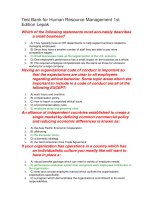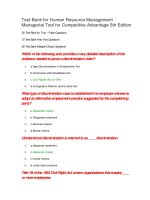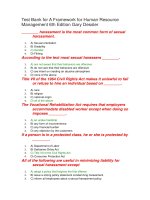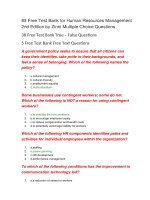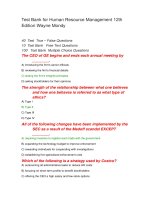Test bank for a framework for human resource management 6th edition by dessler
Bạn đang xem bản rút gọn của tài liệu. Xem và tải ngay bản đầy đủ của tài liệu tại đây (70.99 KB, 18 trang )
Full file at />A Framework for Human Resource Management, 6e (Dessler)
Chapter 1 Managing Human Resources Today
1) ________ maintain contact within the community and publicize openings.
A) Job Analysts
B) EEO representatives
C) Recruiters
D) Compensation managers
Answer: C
Diff: 2 Page Ref: 5
Objective: Chapter objective 1
2) ________ search for qualified job applicants.
A) EEO representatives
B) Job analysts
C) Recruiters
D) Training specialists
Answer: C
Diff: 2 Page Ref: 5
Objective: Chapter objective 1
3) ________ investigate EEO grievances.
A) EEO representatives
B) Training specialists
C) Recruiters
D) Job analysts
Answer: A
Diff: 1 Page Ref: 5
Objective: Chapter objective 1
4) ________ examines current organizational practices for affirmative action violations.
A) EEO representative
B) Training specialist
C) Job analyst
D) Compensation managers
Answer: A
Diff: 1 Page Ref: 5
Objective: Chapter objective 1
5) ________ collects detailed information about job duties.
A) EEO representative
B) Job analyst
C) Compensation manager
D) Recruiter
Answer: B
Diff: 1 Page Ref: 5
Objective: Chapter objective 1
buy this full document at
Full file at />6) ________ use detailed information to prepare job descriptions.
A) EEO representatives
B) Compensation managers
C) Job analysts
D) Recruiters
Answer: C
Diff: 2 Page Ref: 5
Objective: Chapter objective 1
7) ________ develop pay grades and compensation plans.
A) Compensation managers
B) Recruiters
C) Job analysts
D) Trainers
Answer: A
Diff: 1 Page Ref: 5
Skill: AACSB: Reflective Thinking
Objective: Chapter objective 1
8) ________ manage the employee benefits program.
A) Trainers
B) Benefits planners
C) Compensation managers
D) EEO representatives
Answer: C
Diff: 1 Page Ref: 5
Skill: AACSB: Analytical Skills
Objective: Chapter objective 1
9) ________ plan training activities.
A) Training specialists
B) Corporate teachers
C) Managers
D) Job analysts
Answer: A
Diff: 1 Page Ref: 5
Objective: Chapter objective 1
10) ________ organize all the training and development opportunities for a company.
A) Trainings specialists
B) Change managers
C) EEO representatives
D) Communication directors
Answer: A
Diff: 1 Page Ref: 5
Objective: Chapter objective 1
buy this full document at
Full file at />11) The ________ HR group focuses on using centralized call centers to provide specialized
support to the company's employees.
A) corporate
B) centers of expertise
C) transactional
D) embedded
Answer: C
Diff: 3 Page Ref: 5
Objective: Chapter objective 1
12) The ________ HR group focuses on assisting top management in strategic planning.
A) corporate
B) centers of expertise
C) embedded
D) transactional
Answer: A
Diff: 1 Page Ref: 5
Objective: Chapter objective 1
13) The ________ HR group focuses on being HR business partners to specific departments.
A) embedded
B) corporate
C) centers of expertise
D) transactional
Answer: A
Diff: 2 Page Ref: 5
Objective: Chapter objective 1
14) The ________ HR group operates like a specialized HR consulting firm.
A) transactional
B) corporate
C) embedded
D) centers of expertise
Answer: D
Diff: 1 Page Ref: 5
Objective: Chapter objective 1
15) The ________ HR group may provide specialized support for organizational change.
A) transactional
B) corporate
C) embedded
D) centers of expertise
Answer: D
Diff: 2 Page Ref: 5
Objective: Chapter objective 1
buy this full document at
Full file at />16) The ________ HR group may work with benefits specialists to provide support for
transactional HR activities.
A) corporate
B) embedded
C) transactional
D) compensation
Answer: C
Diff: 2 Page Ref: 5
Objective: Chapter objective 1
17) The ________ HR group operates as relationship managers for the corporation.
A) transactional
B) training
C) embedded
D) centers of expertise
Answer: C
Diff: 1 Page Ref: 5
Objective: Chapter objective 1
18) The ________ HR group works with the top management team to develop long range plans
for the company.
A) transactional
B) embedded
C) centers of expertise
D) corporate
Answer: D
Diff: 2 Page Ref: 5
Objective: Chapter objective 1
19) ________ is the process of acquiring, training, appraising, and compensating employees, and
attending to their labor relations, health and safety, and fairness concerns.
A) Human Resource Management
B) Labor Relations
C) Organizational Behavior
D) Organizational Health and Safety Management
Answer: A
Diff: 1 Page Ref: 2
Objective: Chapter objective 1
buy this full document at
Full file at />20) Human resource management is ________.
A) the concepts and techniques used to control people at work
B) the process of organizing work activities
C) the process of identifying countries with cheaper labor costs and relocating jobs to those
countries
D) the process of acquiring, training, appraising, and compensating employees, and attending to
their labor relations, health and safety, and fairness concerns
Answer: D
Diff: 1 Page Ref: 2
Objective: Chapter objective 1
21) ________ is the right to make decisions, to direct the work of others, and to give orders.
A) Leadership
B) Authority
C) Delegation
D) Management
Answer: B
Diff: 1 Page Ref: 3
Objective: Chapter objective 1
22) All of the following are a line supervisor's responsibilities for effective HRM except
A) coercing other supervisors to get with the program
B) controlling labor costs
C) developing the abilities of each person
D) orienting new employees
Answer: A
Diff: 3 Page Ref: 4
Skill: AACSB: Reflective Thinking
Objective: Chapter objective 1
23) Which of the following is a mistake you do not want to make while managing?
A) have your employees not performing at peak capacity
B) hire the wrong person for the job
C) find employees not doing their best
D) all of the above
Answer: A
Diff: 2 Page Ref: 3
Objective: Chapter objective 2
24) ________ are authorized to direct the work of subordinates.
A) Line managers
B) Staff managers
C) Advisory board members
D) All of the above
Answer: A
Diff: 1 Page Ref: 3
Objective: Chapter objective 1
buy this full document at
Full file at />25) ________ are responsible for assisting and advising line managers in areas like recruiting,
hiring, and compensation.
A) Human resource managers
B) Staff managers
C) Line managers
D) EEO officers
Answer: A
Diff: 1 Page Ref: 4
Objective: Chapter objective 1
26) Effective human resource management could include all of the following responsibilities
except
A) placing the right person in the right job
B) training employees
C) controlling labor costs
D) all are responsibilities necessary for effective human resource management
Answer: D
Diff: 2 Page Ref: 4
Objective: Chapter objective 1
27) All of the following are examples of human resource job duties except
A) recruiter
B) equal employment opportunity coordinator
C) financial advisor
D) labor relations specialist
Answer: C
Diff: 2 Page Ref: 5
Objective: Chapter objective 1
28) Which of the following job titles indicates a position in human resources?
A) recruiter
B) training specialist
C) EEO coordinator
D) all of the above
Answer: D
Diff: 2 Page Ref: 5
Objective: Chapter objective 1
29) ________ refers to the tendency of firms to extend their sales, ownership, and/or
manufacturing to new markets abroad.
A) Market development
B) Globalization
C) Export growth
D) Diversification
Answer: B
Diff: 1 Page Ref: 7
Objective: Chapter objective 3
buy this full document at
Full file at />30) Which of the following demographic issues represents a challenge for human resource
managers?
A) increasingly diverse workforce
B) aging workforce
C) increasing use of contingent workers
D) both A and B
Answer: D
Diff: 2 Page Ref: 10
Objective: Chapter objective 3
31) The proportion of younger workers in the workforce is projected to ________.
A) stop growing
B) decrease
C) increase at a decreasing rate
D) decrease at an increasing rate
Answer: B
Diff: 3 Page Ref: 9
Objective: Chapter objective 3
32) Over the next few years, employers may face a severe labor shortage because ________.
A) there are fewer people entering the job market than there are retiring baby boomers
B) one-third of single mothers are not in the labor force
C) people are living longer
D) all of the above
Answer: A
Diff: 3 Page Ref: 9
Objective: Chapter objective 3
33) What tactic will employers likely have to take to fill openings left by retiring employees?
A) instituting flexible work hours
B) hiring more women
C) rehiring retirees
D) lowering the retirement age
Answer: C
Diff: 3 Page Ref: 10
Objective: Chapter objective 3
34) A ________ is a company's plan for how it will balance its internal strengths and weaknesses
with external opportunities and threats in order to maintain a competitive advantage.
A) mission statement
B) strategy
C) tactic
D) scorecard
Answer: B
Diff: 1 Page Ref: 18
Objective: Chapter objective 5
buy this full document at
Full file at />35) Strategic human resource management refers to ________.
A) formulating and executing human resource policies and practices that produce the employee
competencies and behaviors the company needs to achieve strategic aims
B) planning the balance of internal strengths and weaknesses with external opportunities and
threats to maintain competitive advantage
C) emphasizing the knowledge, education, training, skills, and expertise of a firm's workers
D) extending a firm's sales, ownership, and manufacturing to new markets
Answer: A
Diff: 2 Page Ref: 20
Objective: Chapter objective 5
36) Which term refers to letting vendors abroad provide services for a firm?
A) external work systems
B) application service providers
C) off shoring
D) data warehousing
Answer: C
Diff: 1 Page Ref: 9
Objective: Chapter objective 5
37) ________ refers to the tendency of firms to extend their ownership to new markets abroad.
A) Strategic human resources
B) Trend analysis
C) Globalization
D) Outsourcing
Answer: C
Diff: 3 Page Ref: 7
Objective: Chapter objective 5
38) Which organization provides professional certification for human resource managers?
A) Academy of Management
B) Society for Human Resource Management
C) Academy of HR Partners
D) Association of Business Administration
Answer: B
Diff: 1 Page Ref: 18
Objective: Chapter objective 5
39) HR managers who pass certification exams in human resource management are
knowledgeable in all of the following aspects except
A) strategic management
B) information technology
C) employee and labor relations
D) occupational health and safety
Answer: B
Diff: 1 Page Ref: 18
Objective: Chapter objective 5
buy this full document at
Full file at />40) The term, ________, refers to the standards someone uses to decide what his or her conduct
should be.
A) morals
B) ethics
C) autonomy
D) responsibility
Answer: B
Diff: 1 Page Ref: 15
Skill: AACSB: Ethical Reasoning
Objective: Chapter objective 5
41) Today over ________% of the U.S. workforce is employed in producing or delivering
services.
A) 25
B) 50
C) 66
D) 75
Answer: C
Diff: 2 Page Ref: 8
Objective: Chapter objective 5
42) Which of the following is an example of HR management's changing role?
A) HR managers must measurably improve organizational performance.
B) HR managers must represent the organization even when they are off the clock.
C) HR managers must be individually centered so as to ensure that there will be no favoritism.
D) none of these
Answer: A
Diff: 3 Page Ref: 17
Skill: AACSB: Reflective Thinking
Objective: Chapter objective 4
43) In today's business environment ________ are often the firm's main source of competitive
advantage.
A) machines
B) highly trained and committed employees
C) superior organization
D) superior advertising
Answer: B
Diff: 3 Page Ref: 20
Skill: AACSB: Reflective Thinking
Objective: Chapter objective 4
buy this full document at
Full file at />44) Which of the following is not a factor changing the environment of HRM?
A) demographic trends
B) economic trends
C) "generation Y"
D) all of the above
Answer: D
Diff: 2 Page Ref: 7-11
Objective: Chapter objective 3
45) All of the following are new HRM skills except
A) improving off shoring skills
B) supplying transactional services while serving more strategic, internal consulting activities
C) improving internal consulting skills
D) all of these
Answer: D
Diff: 3 Page Ref: 14-17
Skill: AACSB: Reflective Thinking
Objective: Chapter objective 5
46) A(n) ________ is a system that enables employees to manage their own benefits and update
their personal information.
A) web portal
B) cybernetic system
C) formulative system
D) software based system
Answer: A
Diff: 2 Page Ref: 15
Skill: AACSB: Use of IT
Objective: Chapter objective 5
47) Which of the following is not a technology that HR managers use?
A) streaming PC video
B) personal digital assistants
C) monitoring software
D) all of the above
Answer: D
Diff: 2 Page Ref: 15
Objective: Chapter objective 5
48) How many of the ten most serious ethical issues were HR related?
A) six
B) ten
C) seven
D) four
Answer: A
Diff: 2 Page Ref: 15
Skill: AACSB: Ethical Reasoning
Objective: Chapter objective 5
buy this full document at
Full file at />49) When acting as an internal consultant an HR team should ________.
A) contribute to discussions only when asked
B) prepare themselves for adverse opinions
C) identify and institutionalize changes
D) break the will of the line managers to ensure there will be no resistance to changes
Answer: C
Diff: 3 Page Ref: 14
Skill: AACSB: Reflective Thinking
Objective: Chapter objective 3
50) Which of the following is not an issue that HR managers have to deal with today?
A) managing ethics
B) understanding strategic planning
C) understanding how to utilize technology
D) utilizing transactional relations to ensure success
Answer: D
Diff: 2 Page Ref: 14-15
Skill: AACSB: Reflective Thinking
Objective: Chapter objective 3
51) Workers who hold multiple jobs or are contingent or part-time are called ________.
A) disposable
B) seasonal
C) temporary
D) nontraditional
Answer: D
Diff: 2 Page Ref: 10
Objective: Chapter objective 3
52) Setting standards such as sales quotas, quality standards, or production levels is part of the
leading function of human resource management.
Answer: FALSE
Diff: 2 Page Ref: 2
Objective: Chapter objective 1
53) Ethical decisions never involve morality.
Answer: FALSE
Diff: 2 Page Ref: 15
Skill: AACSB: Ethical Reasoning
Objective: Chapter objective 5
54) The individual supervisor's HRM related duties have not changed much in many years.
Answer: TRUE
Diff: 3 Page Ref: 4
Objective: Chapter objective 3
buy this full document at
Full file at />55) There is presently a growing need for knowledge workers.
Answer: TRUE
Diff: 1 Page Ref: 8
Objective: Chapter objective 1
56) Industries in production and operation still employee the majority of the U.S. workforce.
Answer: FALSE
Diff: 2 Page Ref: 8
Objective: Chapter objective 1
57) After a period of years, the trend of offshoring is steadily slowing down - with many
companies bringing jobs back to the U.S.
Answer: FALSE
Diff: 1 Page Ref: 9
Objective: Chapter objective 1
58) Staff managers are authorized to direct the work of subordinates and are directly in charge of
accomplishing the organization's basic goals.
Answer: FALSE
Diff: 1 Page Ref: 3
Objective: Chapter objective 1
59) The biggest demographic threat affecting employers is retirees.
Answer: TRUE
Diff: 1 Page Ref: 10
Objective: Chapter objective 2
60) Human resource managers are generally staff managers.
Answer: TRUE
Diff: 1 Page Ref: 4
Objective: Chapter objective 1
61) Staff managers are always someone's boss.
Answer: FALSE
Diff: 2 Page Ref: 3
Objective: Chapter objective 1
62) The inability to recruit and maintain a good workforce constitutes a bottleneck for a
developing industry.
Answer: TRUE
Diff: 2 Page Ref: 3
Objective: Chapter objective 1
63) In small organizations, line managers may carry out all personnel duties without the
assistance of a human resource staff.
Answer: TRUE
Diff: 2 Page Ref: 4
Objective: Chapter objective 1
buy this full document at
Full file at />64) Line managers can only assist and advise staff managers.
Answer: FALSE
Diff: 2 Page Ref: 4
Objective: Chapter objective 2
65) Human resource managers assist in hiring, training, evaluating, rewarding, counseling,
promoting, and hiring employees.
Answer: TRUE
Diff: 1 Page Ref: 2
Objective: Chapter objective 1
66) HR is small businesses are shrunken versions of big-company HRM.
Answer: FALSE
Diff: 1 Page Ref: 5
Skill: AACSB: Reflective Thinking
Objective: Chapter objective 2
67) Supervisors do not spend much of their time on HR/personnel-type tasks.
Answer: FALSE
Diff: 1 Page Ref: 4
Objective: Chapter objective 1
68) In the majority of firms, the task of interviewing job candidates is shared between HR and
the hiring department.
Answer: TRUE
Diff: 1 Page Ref: 4
Objective: Chapter objective 1
69) With the aging of its workforce, America is facing a demographic shift as significant as the
massive entry of women into the workforce that began in the 1960s.
Answer: TRUE
Diff: 2 Page Ref: 9
Objective: Chapter objective 1
70) In the IBM example in the text "silos" were identified as a problem in the inadequacy with
which different needs were served by the HR department.
Answer: TRUE
Diff: 3 Page Ref: 7
Skill: AACSB: Analytical Skills
Objective: Chapter objective 2
71) As baby boomers retire from the workforce, there will be more people entering the labor pool
than leaving it.
Answer: FALSE
Diff: 3 Page Ref: 9
Objective: Chapter objective 3
buy this full document at
Full file at />72) The SHRM Human Resource Certification exams include testing on management practices,
staffing, development, compensation, labor relations, and health and safety.
Answer: TRUE
Diff: 2 Page Ref: 18
Objective: Chapter objective 5
73) Human resource managers are no longer strategic players, but instead provide transactional
support.
Answer: FALSE
Diff: 2 Page Ref: 14
Objective: Chapter objective 5
74) Human resource managers must find new ways to offer traditional transactional HR services.
Answer: TRUE
Diff: 2 Page Ref: 14
Objective: Chapter objective 5
75) Monitoring software has been found to be illegal for use by human resource manager.
Answer: FALSE
Diff: 2 Page Ref: 15
Objective: Chapter objective 5
76) Human resource managers can complete professional certification exams to earn the SPHR
or PHR certificates.
Answer: TRUE
Diff: 1 Page Ref: 18
Objective: Chapter objective 5
77) Ethical issues such as workplace safety, security of employee records, comparable work, and
employee privacy rights are all related to human resource management.
Answer: TRUE
Diff: 2 Page Ref: 15
Objective: Chapter objective 5
78) "Safe" workplaces produce just as many lost-time accidents and costs than do "unsafe."
Answer: FALSE
Diff: 2 Page Ref: 16
Skill: AACSB: Ethical Reasoning
Objective: Chapter objective 5
79) Today's trend is for HR managers to spend more time on administrative, transactional
services.
Answer: FALSE
Diff: 2 Page Ref: 14
Objective: Chapter objective 4
buy this full document at
Full file at />80) Studies show that top managers still do NOT recognize teh crucial role human resource
managers can play in achieving strategic goals.
Answer: FALSE
Diff: 2 Page Ref: 17
Skill: AACSB: Ethical Reasoning
Objective: Chapter objective 5
81) A strategy is the company's plan on how it will match its internal strengths and weaknesses
with its external opportunities and threats.
Answer: TRUE
Diff: 2 Page Ref: 18
Objective: Chapter objective 5
82) Human resource management refers to the practices and policies organizations need to carry
out the personnel aspects required. What do these include? List 5.
Answer:
Conducting job analysis
Planning labor needs
Selecting job candidates
Orienting new employees
Appraising performance
Managing wages and salaries
Providing incentives
Communicating
Diff: 1 Page Ref: 2
Skill: AACSB: Analytical Skills
Objective: Chapter objective 1
83) Why are human resource concepts and techniques important to all managers? List 5 reasons.
Answer:
You don't want:
to have your employees not performing at peak capacity
to hire the wrong person for the job
to experience high turnover
to find employees not doing their best
to have your company taken to court because of your discriminatory actions
to commit any unfair labor practices
Diff: 2 Page Ref: 2
Objective: Chapter objective 1
buy this full document at
Full file at />84) Explain the difference between line authority and staff authority. What type of authority do
human resource managers have?
Answer: Authority is the right to make decisions, to direct the work of others, and to give orders.
Line managers are authorized to direct the work of subordinates and are directly in charge of
accomplishing the organization's basic goals. Staff managers are authorized to assist and advise
line managers in accomplishing these basic goals. Human resource managers are usually staff
managers because they are responsible for assisting and advising line managers in areas like
recruiting, hiring, and compensation. However, human resource managers do have line authority
within their own department.
Diff: 2 Page Ref: 3-5
Skill: AACSB: Analytical Skills
Objective: Chapter objective 1
85) What are the four main ways that technology improves HR functioning?
Answer: Technology improves HR functioning through self-service options, call centers,
productivity improvement, and outsourcing.
Diff: 2 Page Ref: 14-15
Skill: AACSB: Use of IT
Objective: Chapter objective 5
86) Describe the changing environment of Human Resource Management.
Answer: A suitable answer to this question would address the impact of globalization, off
shoring, technological advances, the changing nature of work, human capital growing
importance, demographic and workforce trends and the impact of "Generation Y." Examples
should be offered to support any opinions given and to bolster the argument that this does indeed
affect the environment.
Diff: 3 Page Ref: 14-18
Skill: AACSB: Reflective Thinking
Objective: Chapter objective 3
87) What are the four new ways to organize human resource services?
Answer:
The transactional HR group
The corporate HR group
The embedded HR group
Centers of Expertise
Diff: 2 Page Ref: 5
Skill: AACSB: Ethical Reasoning
Objective: Chapter objective 1
buy this full document at
Full file at />88) What are the five job duties for the human resource department?
Answer: Recruiters
Equal employment opportunity representatives
Job analysts
Compensation managers
Training specialists
Diff: 1 Page Ref: 5
Skill: AACSB: Analytical Skills
Objective: Chapter objective 1
89) List and explain 5 personnel mistakes you don't want to make as a manager.
Answer: The answer should include any of the following: to have your employee not performing
at peak, to hire the wrong person, to experience high turnover, to have employees not doing their
best, to have the company taken to court because of discriminatory actions, to have your
company cited for safety violations, to have undertrained employees and to commit unfair labor
practices. Because this is the first chapter material and the items listed above are not elaborated
upon the grader should allow for logical, even if incorrect, explanations for the chosen 5.
Diff: 1 Page Ref: 2
Skill: AACSB: Communication
Objective: Chapter objective 2
90) Why are demographic trends important to HR managers?
Answer: HR managers need to be cognizant of demographic trends because changes in the
availability of workers directly affect recruiting and selection efforts. The changes in the
workforce can impact the availability of technologically savvy employees or the availability of
skilled labor. additionally the availability of employees affect the compensation that needs to be
offered to attract and retain valued employees.
Diff: 3 Page Ref: 9
Skill: AACSB: Reflective Thinking
Objective: Chapter objective 3
91) Explain the concept of Strategic Human Resource Management.
Answer: A suitable answer would include the definition and an explanation of what it means.
Emphasis should be given to the involvement of HR in decisions before plans are made instead
of when plans need to be implemented. The student may also discuss the role of HR in spotting
trends that may become useful in the future.
Diff: 3 Page Ref: 20
Skill: AACSB: Reflective Thinking
Objective: Chapter objective 3
92) To what does human capital refer?
Answer: Human capital refers to the knowledge, education, training, skills, and expertise of a
firm's workers.
Diff: 1 Page Ref: 8
Objective: Chapter objective 2
buy this full document at
Full file at />93) To what does ethics refer?
Answer: Ethics refers to the standards someone uses to decide what his or her conduct should
be.
Diff: 1 Page Ref: 15
Skill: AACSB: Communication
Objective: Chapter objective 3
94) What is ethics?
Answer: Ethics refers to the standards someone uses to decide what his or her conduct should
be. Ethical decisions always involve morality.
Diff: 1 Page Ref: 13
Skill: AACSB: Communication
Objective: Chapter objective 5
95) Explain what it means to have authority.
Answer: Authority is the right to make decisions, to direct the work of others and to give orders.
Diff: 1 Page Ref: 3
Objective: Chapter objective 1
buy this full document at

